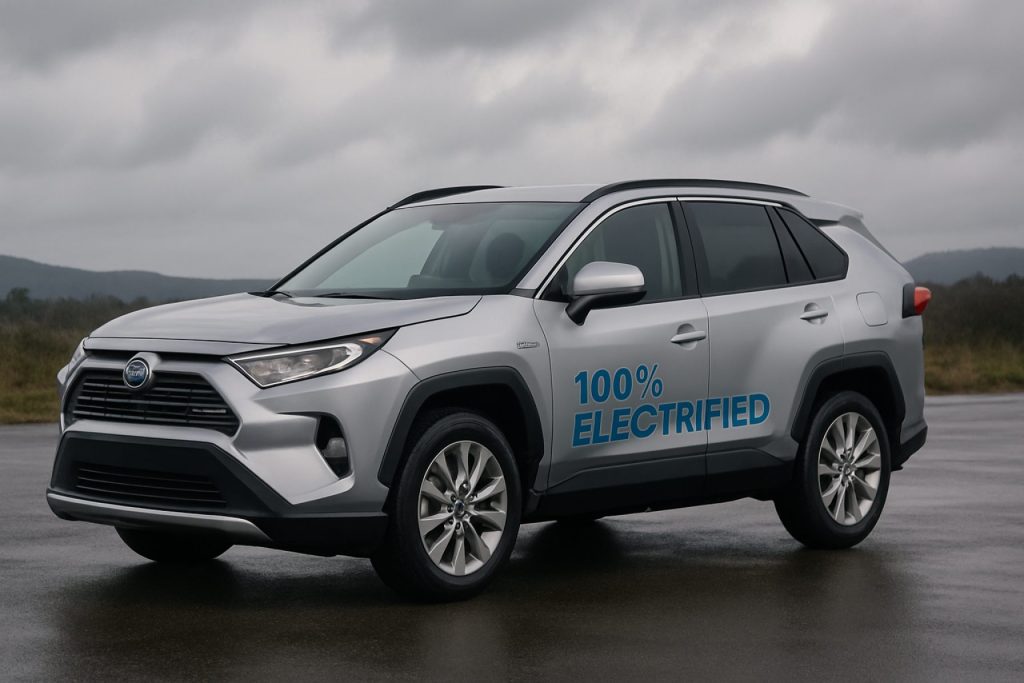
- Toyota ends gasoline-only RAV4s for 2026; all models will be hybrid (HEV) or plug-in hybrid (PHEV), with no fully electric option.
- Despite “100% electrified” branding, every RAV4 still uses gasoline; none are true EVs (electric-only vehicles).
- Improved PHEV offers 50 miles electric-only range and DC fast charging on select trims.
- New Woodland and GR SPORT models target trail and sport enthusiasts but remain hybrids at heart.
- Critics warn the “electrified” claim may mislead consumers and blur the line between hybrid and fully electric vehicles.
- Regulators and advocates remain watchful over muddled green marketing and environmental promises.
Shifting Gears on a Landmark SUV
The unmistakable roar of a classic Toyota combustion engine is gone from the RAV4 lineup, replaced instead by a chorus of electric motors and gas engines working in uneasy concert. With the 2026 model, Toyota puts its enduring bestseller on a fresh track, announcing the end of purely gasoline RAV4s and declaring that only hybrid (HEV) and plug-in hybrid (PHEV) versions will roll off dealer lots.
Yet as customers walk past the sharply restyled bodywork, a new slogan shouts from billboards and brochures: “100% electrified.” The declaration raises eyebrows, not excitement. Buried beneath the buzz, every single RAV4 is still powered, in part, by gasoline. Zero non-hybrid engines, yet also zero models that run exclusively on electrons.
New Woods, New Wolves, Same Old Howl?
- Woodland Model – Rugged, ready for the trail, drawing inspiration from Toyota’s bZ electric line.
- GR SPORT – Promises sharper handling and more power, though purists will note: SUV DNA can only stretch so far toward true sports car thrills.
- Improved PHEV range, now 50 miles electric-only, up from 42. Solid for daily commutes—if drivers actually plug in.
- Selective trims offer DC fast charging, juicing from 10–80% in just half an hour.
Painted in ambitious new colors and equipped with larger batteries, the 2026 RAV4 hits the lot later this year. Price tags remain cloaked in secrecy. Exact fuel economy figures? Also under wraps, though expectations hover around the current 39mpg of Toyota’s existing hybrid SUV.
An Electrified Deception?
Within the auto industry, jargon is weaponized. Terms like EV, PHEV, HEV, BEV, and phrases like “electrified” or “all-electric” are tossed about with abandon. Once, “100% electric” was reserved solely for vehicles severed from fossil fuels. Now, by christening a hybrid fleet as “100% electrified,” Toyota has leapt beyond the bounds of marketing euphemism.
It’s a maneuver that stirs skepticism among seasoned observers. Toyota’s track record includes fending off environmental regulations, funding climate skepticism, and—critics say—playing fast and loose with the language of electrification. In the US and Norway, regulators have slapped their hands over advertising that stretches truth past breaking points. This latest move, critics argue, risks confusing eco-conscious consumers, wrapping incremental progress in a cloak of exaggerated green promises.
Why the Change Really Matters
At a time when competitors race to shed gasoline altogether, Toyota inches forward, lacing every RAV4 with batteries—but refusing to unplug the gas tank. There’s no fully electric RAV4. For that, you’ll have to look to the bZ electrified sub-brand—a calculated separation, perhaps, to keep the ICE (internal combustion engine) flame alive under a glossy hybrid hood.
- The daily driver will benefit: most can run errands on electric power if, and only if, they charge each night.
- On long-haul trips, the trusty gas engine still hums back to duty. Cleaner? Absolutely. 100% electric? Hardly.
- The difference matters to regulatory bodies, environmental advocates, and customers diligently following emission footprints.
The Road Ahead
Toyota’s move to hybrids only in America’s favorite SUV is a seismic shift—environmentalists and efficiency hawks should cheer. But its attempt to redefine “electrified” is a bold play that risks eroding consumer trust and industry credibility. In a landscape of increasing climate urgency, the line between progress and public relations grows ever finer.
The 2026 Toyota RAV4 will be available at Toyota dealerships nationwide later this year. Whether its “100% electrified” promise inspires—or provokes—remains to be seen.
What Toyota Isn’t Telling You About the “100% Electrified” RAV4
-
Pros:
- Lower Emissions: All 2026 RAV4s feature hybrid or plug-in hybrid systems, significantly reducing tailpipe emissions compared to traditional gasoline-only models.
- Increased Electric Range: The latest PHEV can travel up to 50 miles on electricity alone—ideal for daily commuting if routinely plugged in.
- Faster Charging: Select trims now offer DC fast charging, recharging the battery from 10–80% in just 30 minutes.
- Diverse Trims: Options like the rugged Woodland and sporty GR SPORT trims cater to various driver personalities and needs.
-
Cons & Controversies:
- Marketing Stretch: The “100% electrified” slogan is controversial—every RAV4 still relies on gasoline. There are no fully electric versions in the lineup.
- Potential Consumer Confusion: Toyota’s phrasing may mislead customers into believing they’re buying a zero-emissions or pure EV product when they’re not.
- No Full EV Option: Buyers seeking a completely gas-free SUV will not find it here; for that, they must consider the Toyota bZ series, which is separate from RAV4.
- Regulatory Backlash: Advertising regulators in the US and Norway have criticized Toyota‘s previous campaigns for overstating environmental benefits.
-
Limitations:
- Dependency on Charging: To reap the electric range benefits, owners must consistently plug in—a behavioral shift many may overlook.
- Unknown Pricing & MPG: Toyota has not yet released official price tags or precise fuel efficiency figures for the 2026 models.
- Half-Steps Toward Electrification: While competitors are moving to full EVs, the RAV4’s continued reliance on gasoline marks a more cautious (some say stagnant) approach.
Bottom line? The new RAV4 offers incremental progress—lower emissions, better range, attractive trims—but also raises pressing questions about greenwashing and the true meaning of “electrified” in the Toyota showroom.
Stunned by “100% Electrified”? See What’s Next for SUVs!
-
Accelerating the Hybrid Revolution
Toyota’s shift to exclusively hybrid and plug-in hybrid RAV4s signals a broader industry pivot. The coming years will likely see a growing number of automakers replacing pure gasoline models with hybrids, blurring lines between traditional and electrified vehicles. Expect terms like “100% electrified” to become mainstream buzzwords—even as definitions remain disputed.
-
Longer Electric-Only Range
The next generation of plug-in hybrids will push all-electric ranges even higher, with rumors suggesting near triple-digit mileage on a single charge. DC fast charging—once reserved for full EVs—may become standard or widely available on premium hybrid trims. Follow developments at the source: Toyota.
-
The Hybrid-EV Divide Widens
Brands are creating separate sub-brands for their true battery-electric vehicles, as with Toyota’s bZ series. Experts predict an expanding split—hybrids will serve as the new norm for mainstream models while dedicated EV sub-brands target early adopters and eco-enthusiasts. More details on evolution at Toyota.
-
Regulatory Pressure and Green Marketing
Governments in the US, Europe, and Asia are tightening standards on emissions and advertising claims. Watch for stricter policing of “electrified” language and growing fines for misleading campaigns. See regulatory trends on official sources like Toyota for company statements and compliance updates.
-
Consumer Skepticism and Education
As electrified jargon saturates advertising, consumers will demand transparency. Independent reviews, clear emissions data, and official ratings will become vital for buyer trust. Stay informed using resources provided by automakers at Toyota.
Forecast: By the end of this decade, hybrids may dominate dealership lots, with pure gasoline engines relegated to niche or off-road segments. Fully electric SUVs will rise, but for the next 3–5 years, the hybrid compromise—backed by clever marketing—will steer the direction of mass-market crossovers.



